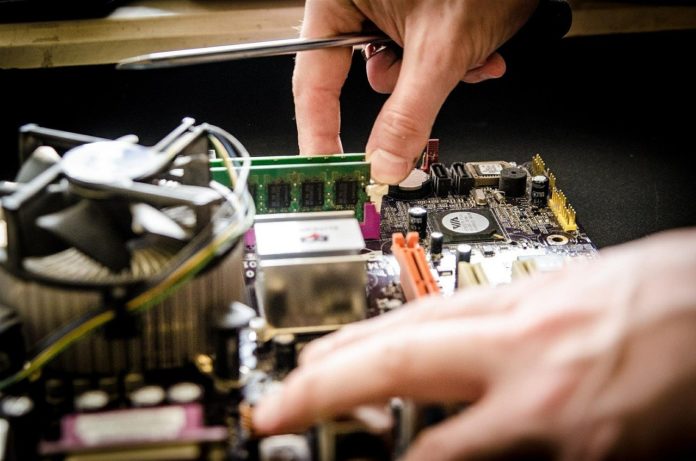Electronic components are parts of electrical & electronic circuits and as such, each component has a functionality according to its operational characteristics. For example, in our discussion below we explore a list of items that will mainly fall into one of these two distinct categories:
- Passive Components – have no gain and do not need additional power, for example, transformers, wires, capacitors, switches.
- Active Components – have gain and need additional power, for example, relays, transistors, amplifiers, etc.
Electronic Components List
From our research we have found that most Original Equipment Manufacturers (OEMs) in the electrical and electronics industry will have electronic components list in their Bill of Material.
- Microcontroller – Microcontrollers also known as MCU (Microcontroller Unit) are small computers i.e., IC used in embedded systems to control a multitude of devices, such as power tools, remote controls, medical equipment, and office machines. It processes data using its CPU from data fed in its input pins and outputs it via output pins and in consumer good they tend to control washing machine cycles and HVAC conditioning units in white goods like the STM32F103C8T6 by STMicroelectronics 48 pin MCU.
- Transformer – (Not the movie!) Is a passive device built with two coils of wire and it functions by transferring electrical energy from one circuit to another through induction or in simpler terms used to step up or step-down power.
- Battery – Batteries convert chemical energy to electrical energy. The two different cells of a battery are anode (+) and cathode (-)
- Fuse & Circuit breakers – Electricity can be hazardous and that is why we need fuses and circuit breakers. They tend to protect electrical circuits and appliances. Fuses protect components from overloading when exposed to excessive current. The general composition of a fuse includes contacts, connection body, support, and metal-fuse material such as copper or zinc. Circuit Breakers are also protective devices and can be controlled with a remote switch and like fuses, they protect the circuit from overloading or having a short circuit.
- Transistors: They form the building blocks of microchips and are very easy to identify through their three pin terminals. A very popular example is the 2N3904 transistor by Multicomp which has a power dissipation of 625mW and emitter voltage of 40V. For the components to work, the electric voltage must be passed to the base terminal.
Fact… The first transistor computer was built by the University of Manchester in 1953 using 200 point-contact transistors.
- Relays – These electromechanical switches shut power on or off. IN definition a relay is an electromagnetic switch operated by a relatively small electric current that can turn on or off a much larger electric current. A typical relay will be made of an electromagnet, a series of electrical contacts, an armature, and a spring. A clever illustration to describe how this works is like having two dogs. Typically, big dogs are not that cautious of the environment as they know they can take anything, so they are sort of lazy. However, small dog breeds like chihuahua tend to be very alert as their defense mechanism. In real life, if this chihuahua heard a noise, it would bark and wake the dangerous big dog which will then attack the incoming dangers. This is the same concept of how relays work.
- Switches – Switches interrupt current. The four types of switches are; single pole single throw (SPST), single pole double throw (SPDT), double pole single throw (DPST), and double pole double throw (DPDT).
- Motors – A motors is a device that turns electrical energy into mechanical. Motors can be classified into 33 namely, AC, DC, and Special motors with their key components being stator, conduit box, rotor, bearings, enclosure, and an eye bolt.
- Capacitors – This is a load-type element in a circuit and basically stores energy electrostatically and usually the charge is stored temporarily i.e., stores electric charges at rest. Once it is connected to another load, the stored energy in the capacitor can then flow to that load. The most common types of capacitors are electrolytic and ceramic disks.
- Resistors – Resistors control voltage flow and usually keep the current at safe levels and thus prevents the equipment from overheating. Resistors are graded based on their power rating and are common in integrated circuits (IC).
Why Buy Online?
The majority of us have access to a handful of modest electronics stores around our towns with a modest selection of components to choose from. However, whilst these electronic stores near us have electronic parts for the normal people who need to do quick fixes, they do not really cater to the hobbyist or maker community who make advanced products for their projects. Unfortunately, many cities in growing economies do not have these anymore. So what do you do? Buy electronic components online!
Common Electronic Components Store & Online Distributors?
Local neighbourhood electronics stores and even big ones do not seem to carry the kind of specific electronic components necessary for new creations and even modifications. Therefore, searching for more niche-specific retailers is the only way to get the parts that you need. A good hack would be using an aggregator website like oemsecrets.com to find electronic components from online distributors.
Farnell Group – Is a global distributor of technology products and solutions for electronic system design, maintenance, and repair. They support the technology community at every stage of their product development. As mentioned above they are global and therefore, you could have your products delivered as fast as possible.
Mouser – They often provide development boards and open-source hardware for hobbyists and makes which speed the time to market for new products. Their website is easy to use, offers free shipping on certain order values and even better is the fact that they do not have MOQ so you’re able to buy just what you need.
Future Electronics – Just like the two brands mentioned above, Future electronics are helping makers shape the future. As a maker you can get support from their engineers for design and solutions and will happily assist you from concept to creation.
Summary
We hope you found this post useful and would love to hear your feedback or even to contribute other common electronic components we might have missed on our list with trending parts. You can contact the writer of this blog here.
Article researched and published by: electronic components writer Ohms Lawrence









